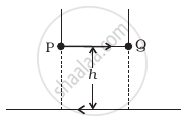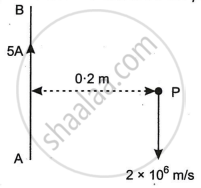Advertisements
Advertisements
प्रश्न
Show that currents in two long, straight, parallel wires exert forces on each other. Derive the expression for the force per unit length on each conductor.
उत्तर
Case I: Both wires carry current in the same direction.
- Consider two long parallel wires separated by distance d and carrying current I1 and I2 respectively same direction as same as shown in the figure below:

Two long parallel wires, distance d apart - The magnetic field at the second wire due to the current I1 in the first one, according to Biot - Savart’s law is B = `(mu_0"I"_1)/(2pi"d")` ….(1)
- By the right-hand rule, the direction of this field is into the plane of the paper.
- Force on the wire 2, because of the current I2 and the magnetic field B due to current in wire 1, applying Lorentz force law is,
F = `"I"_2((mu_0"I"_1)/(2pi"d"))int"dl"` ….(2)
The direction of this force is towards wire 1, i.e., it will be an attractive force. - Force of attraction per unit length of the wire will be
`"F"/"L" = mu_0/(2pi) ("I"_1"I"_2)/"d"` ….(3)
Case II: Two wires carry current in opposite direction.
Force is of repulsive nature between antiparallel currents and the magnitude of the force of repulsion per unit length is, `|"F"/"L"| = mu_0/(2pi) ("I"_1"I"_2)/"d"`
APPEARS IN
संबंधित प्रश्न
Use this law to find magnetic field due to straight infinite current carrying wire.
Obtain an expression for magnetic flux density B at the centre of a circular coil of radius R, having N turns and carrying a current I
Define one tesla using the expression for the magnetic force acting on a particle of charge q moving with velocity \[\vec{v}\] in a magnetic field \[\vec{B}\] .
A straight wire carrying an electric current is placed along the axis of a uniformly charged ring. Will there be a magnetic force on the wire if the ring starts rotating about the wire? If yes, in which direction?
A charged particle is moved along a magnetic field line. The magnetic force on the particle is
A charged particle is released from rest in a region of steady and uniform electric and magnetic fields which are parallel to each other. The particle will move in a ____________.
If a particle of charge 1012 coulomb moving along the `hat"x" -` direction with a velocity 102 m/s experiences a force of 1 o-s newton in `hat"y" -` direction due to magnetic field, then the minimum magnetic field is ____________.
The magnetic moment is NOT associated with ____________.
Lorentz Force generally refers to ______.
Correct unit of magnetic field is ______.
- If v is parallel to B, then path of particle is spiral.
- If v is perpendicular to B, then path of particle is a circle.
- If v has a component along B, then path of particle is helical.
- If v is along B, then path of particle is a circle.
The correct plot of the magnitude of magnetic field `vec"B"` vs distance r from centre of the wire is, if the radius of wire is R.
The magnetic moment of a current I carrying circular coil of radius r and number of turns N varies as ______.
A magnetic field exerts no force on
The magnetic force depends on v which depends on the inertial frame of reference. Does then the magnetic force differ from inertial frame to frame? Is it reasonable that the net acceleration has a different value in different frames of reference?
A long straight wire carrying current of 25 A rests on a table as shown in figure. Another wire PQ of length 1 m, mass 2.5 g carries the same current but in the opposite direction. The wire PQ is free to slide up and down. To what height will PQ rise?

The unit Wbm-2 is equal to ______.
A charge particle moves along circular path in a uniform magnetic field in a cyclotron. The kinetic energy of the charge particle increases to 4 times its initial value. What will be the ratio of new radius to the original radius of circular path of the charge particle:
A unit vector is represented as `(0.8hat"i" + "b"hat"j" + 0.4hat"k")`. Hence the value of 'b' must be ______.
A long straight conductor kept along X' X axis, carries a steady current I along the +x direction. At an instant t, a particle of mass m and charge q at point (x, y) moves with a velocity `vecv` along +y direction. Find the magnitude and direction of the force on the particle due to the conductor.
State the expression for the Lorentz force on a charge due to an electric field as well as a magnetic field. Hence discuss the magnetic force on a charged particle which is (i) moving parallel to the magnetic field and (ii) stationary.
Two long parallel current-carrying conductors are 0.4 m apart in air and carry currents 5 A and 10 A. Calculate the force per metre on each conductor, if the currents are (a) in the same direction and (b) in the opposite direction.
State dimensions of magnetic field.
What is the relation between Tesla and Gauss?
A long straight wire AB carries a current of 5A. P is a proton travelling with a velocity of 2 × 106 m/s, parallel to the wire, 0.2 m from it and in a direction opposite to the current, as shown in Figure below. Calculate the force which magnetic field of the current carrying conductor AB exerts on the proton.

